Hagia Sophia entrance fee & hours (2024) – all you should know
Wondering how to visit Hagia Sophia in Turkey? Here’s everything you should know about the Hagia Sophia entrance fee, opening hours, prayer times, and much more, based on my own recent visit.

Hagia Sophia is the most magical place in Istanbul. Period.
If you visit only one place while you’re here, let it be the 1,500-year old Hagia Sophia.
Hagia Sophia was originally built as a Christian basilica in the 6th century under Byzantine Emperor Justinian I. But that’s not where its story ends!
It later became a mosque after the Ottoman conquest of Constantinople before being turned into a museum and then from 2020 back to the mosque we know today.
Today, it’s a symbol of Istanbul’s fascinating cultural and religious history.
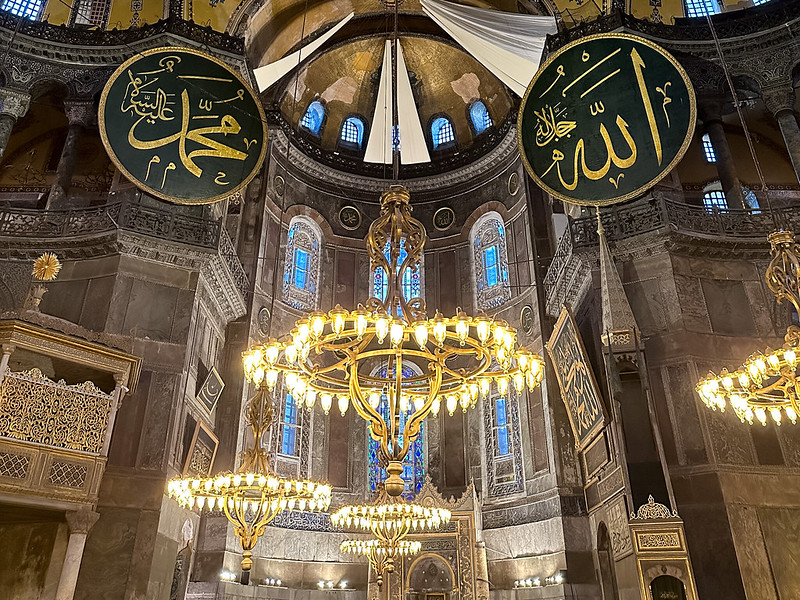
Don’t have time to read the entire article?
- Hagia Sophia entrance fee: €25
- Opening times: 10 am – 10 pm, daily
- Best ⭐ 5.0 tour: Book with Viator
Are you ready to find out everything you should know before visiting this amazing mosque?
Let’s dig in!
This post contains referral links for products I love. Adventurous Miriam earns a small commission at no extra cost to you if you purchase through my links. I appreciate your support ♡ Learn more
About Hagia Sophia
Hagia Sophia is a Byzantine mosque in Istanbul, Turkey. Originally built as a Christian church in the 6th century, it has gone through many changes over the years.
It was a Greek Orthodox church, a Roman Catholic cathedral, an Islamic mosque, a museum, and now a mosque once again.
But what really sets Hagia Sophia apart is its incredible design.
The massive main dome, over 30 meters in diameter, looks like it floats above the space, supported by four huge pendentives resting on large marble piers. It’s lit by a ring of 40 arched windows, which creates an impressive effect!
Read next: 12 most famous mosques in Istanbul you should visit now
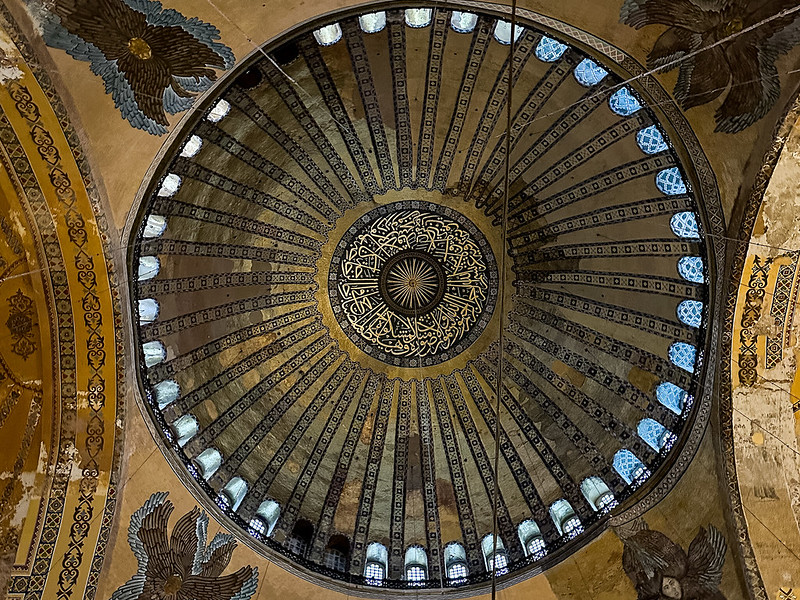
What does Hagia Sophia mean?
Hagia Sophia means “holy wisdom” in Greek.
The name comes from the Greek words Aya (meaning holy or saint) and Sophos (meaning wisdom), and was given to the church as a representation of the Holy Wisdom, the second element of the Christian trinity.

SKIP-THE-LINES Ticket
JOIN A TOUR
Spend your time exploring Hagia Sophia instead of waiting in line.
On this 5-star rated tour (⭐ 5.0), you’ll hear the centuries-old history from a private guide.
Feel free to stay and explore on your own after the 50-minute tour is done.
Aya Sofya history
When was Hagia Sophia built?
Hagia Sophia was built between 532 and 537 under the reign of Byzantine Emperor Justinian I.
It was built as a Christian church, replacing an older church on the site.

When did Hagia Sophia become a mosque?
After the Ottoman Empire conquered Constantinople in 1453, Sultan Mehmed II converted Hagia Sophia into a mosque.
It remained a mosque until 1935 when it was transformed into a museum under the order of Turkish Republic’s founder Mustafa Kemal Atatürk.
In 2020, Hagia Sophia was reconverted into a mosque by the Turkish government.
But why and how did people react?
In July 2020, Turkey’s President Recep Tayyip Erdogan made a controversial decision to convert Hagia Sophia from a museum back into a mosque.
The decision was met with widespread international criticism, including from U.S. and Orthodox Christian leaders. Despite their urging to keep its status as a museum symbolising solidarity among faiths and cultures, Hagia Sophia was converted.
UNESCO expressed “deep regret” at the decision, calling the site a “symbol of tolerance and unity” that holds great meaning for people of all religions.

Hagia Sophia church
Why is Hagia Sophia so important?
Hagia Sophia is significant for several reasons.
For almost a millennium, Hagia Sophia was the largest cathedral in Christianity, serving as a hub of religious, political, and artistic life for the Byzantine world.
After being conquered by Sultan Mehmed II, it became an important site of Muslim worship and remained a mosque until the 1930s when it was converted into a museum.
Today, it is part of the UNESCO World Heritage site and attracts visitors from all over the world who come to admire its architecture, intricate design, huge dome and learn about its fascinating history.
Where is Hagia Sophia
Hagia Sophia is located in Sultanahmet, a historic neighbourhood in Istanbul, Turkey. It’s 500 meters from the Blue Mosque and Topkapi Palace.
How to get to Hagia Sophia
To get to Hagia Sophia, you have several options. If you’re travelling from Istanbul Airport, you can either drive, take a bus, a taxi (not recommended) or pre-order a private driver.
Drive: Rent a car and drive the 49.1 km distance to Hagia Sophia. The journey takes about 36 minutes.
Shuttle: Pre-order a transfer from Istanbul Airport directly to Hagia Sophia. This is what I recommend. This should also take you 36 minutes, and it costs almost the same as a taxi (which will most like try to scam you. I’m speaking from bitter experience).
Getting to Hagia Sophia if you’re already in Istanbul is easy! Simply take the tram to Sultanahmet or walk if you’re close enough.
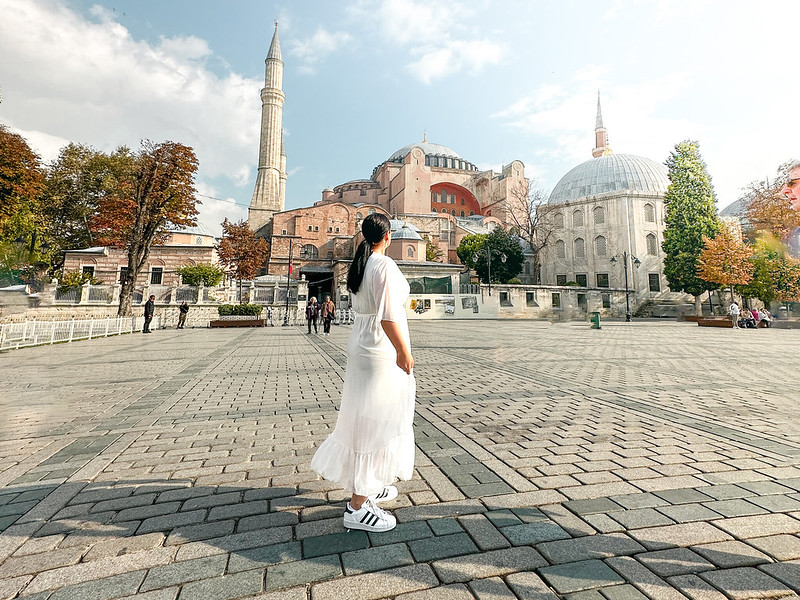
Useful information
Hagia Sophia tickets AND admission fee
Hagia Sophia entrance fee 2024
The entrance fee for Hagia Sophia is now €25.
How to skip the line
The first thing you’ll notice at Hagia Sophia is the long queues. They’re massive. And it will take anywhere from 30 minutes to hours to get in.
There’s a way to skip the line though, and that’s with a guided tour.
This priority tour with Viator (⭐ 5.0 and 142 positive reviews) comes highly recommended and has earned the Badge of Excellence.
It’s a great way to learn about Hagia Sophia to save time and make the most of your vacation time – especially during peak times.

Hagia Sophia opening hours
Hagia Sophia is open year-round from 10 in the morning to 10 in the evening. It’s closed during prayer times.
Hagia Sophia prayer times
The Hagia Sophia closes three times a day for 90 minutes for prayer, and tourists are not allowed to enter during this period. Hagia Sophia is also closed during Friday prayer.
Prayer times change throughout the year, but you can check prayer times here.
What is the best time to visit Hagia Sophia?
The best time to visit Hagia Sophia is in the early morning or late in the afternoon (around 6 pm).
Off-season months like November, February, and March also have fewer visitors.
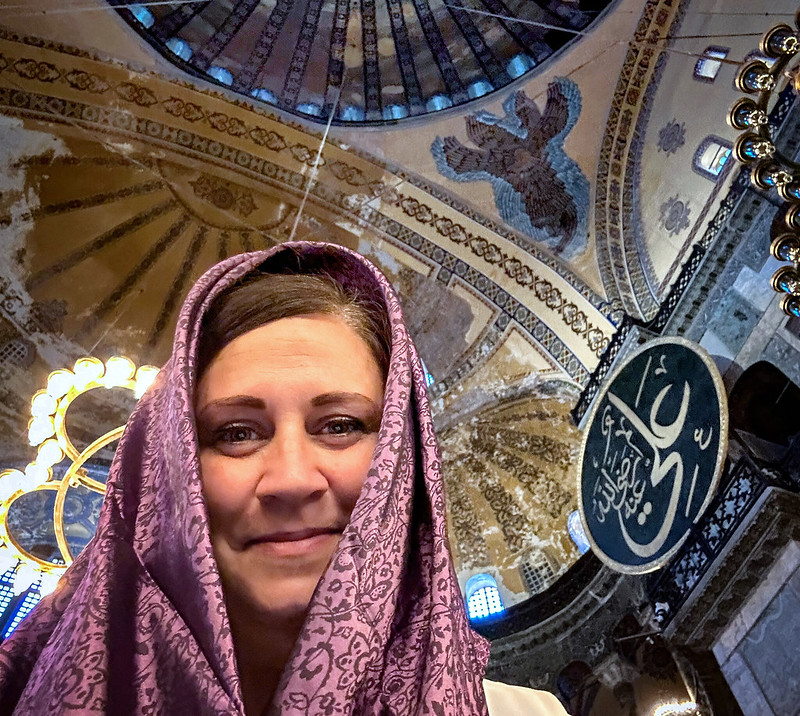
hagia sophia museum
Top travel tips for visiting Aya Sophia
Are the mosaics of Hagia Sophia open?
Yes, the majority of mosaics in Hagia Sophia are open.
Some areas may be undergoing restoration, so make sure to check the official website or inquire with the facility before your visit to be aware of any ongoing maintenance or restrictions.

What to see in Ayasofya?
Here are some highlights of what you can see in Hagia Sophia:
The Deesis Mosaic
This stunning mosaic dates back to the 12th century and depicts Christ Pantocrator.
Omphalion:
The spot where Byzantine emperors were crowned.
Upper Galleries:
The upper galleries allow you to have a closer look at the mosaics and offer a panoramic view of the interior (Currently not open).
Wishing Column:
A column with a hole in the middle; it is believed that if you place your thumb in the hole and rotate it 360 degrees, your wishes will come true.
The Marble Door:
This impressive door was used for ceremonial purposes and separates the southern and northern vestibules of the building.
The central dome:
As mentioned earlier, the central dome is a true masterpiece and the most iconic feature of Hagia Sophia. Look up and notice how it appears to be floating effortlessly above you.
Mosaics:
The interior of Hagia Sophia is adorned with exquisite golden Byzantine mosaics. Depicting religious scenes, the mosaics reflect both Christian and Islamic influences, a testament to the building’s complex history.
Marble columns:
Supporting the structure are 107 massive Greek marble columns, each carved from different types of exotic marble, a sign of the wealth and grandeur of the Byzantine Empire.
The mihrab:
A pivotal religious element in any mosque, the mihrab is the semicircular niche pointing towards Mecca.

Are Hagia Sophia guided tours worth it?
While you can visit Hagia Sophia on your own, a guided tour led by a knowledgeable guide can enhance your experience.
They can provide intriguing details about the history, architecture, and artwork inside the Hagia Sophia. Also, a guided tour can help you navigate the vast complex so you’re sure to cover the most important areas without missing anything.
Another reason to choose a guided tour of Hagia Sophia is that you get to skip the long lines. And trust me, they are long.
This guided tour (⭐ 5.0) is the best-rated Hagia Sophia tour on Viator 👉🏼 Check availability here.
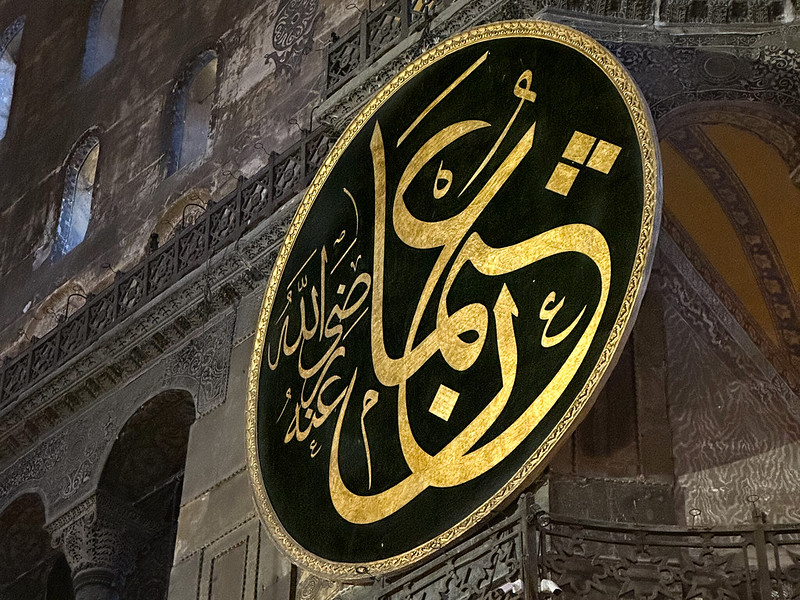
Where to next?
Topkapi Palace
After visiting the Hagia Sophia, make your way over to the nearby Topkapi Palace, an expansive complex that served as the primary residence of Ottoman sultans for nearly 400 years.
The highlight is the Harem, which is incredibly beautiful and provides a glimpse into the private lives of the royal family and their concubines.
This tour (⭐ 5.0) with Viator combines a visit to both Topkapı Palace and Hagia Sophia. Topkapi is huge, so it’s a good idea to have a guide to show the most interesting parts. Book here.
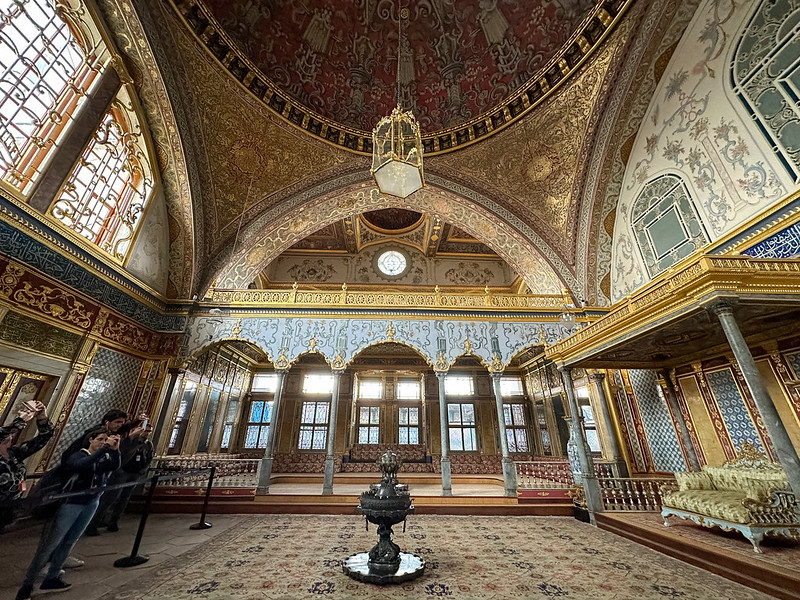
The Blue Mosque
Just a short walk from the Hagia Sophia lies the iconic Blue Mosque. It’s known for its six minarets and beautiful blue Iznik tiles on the interior walls.
Remember to dress modestly and remove your shoes as the Blue Mosque is still an active place of worship. It’s free to visit.
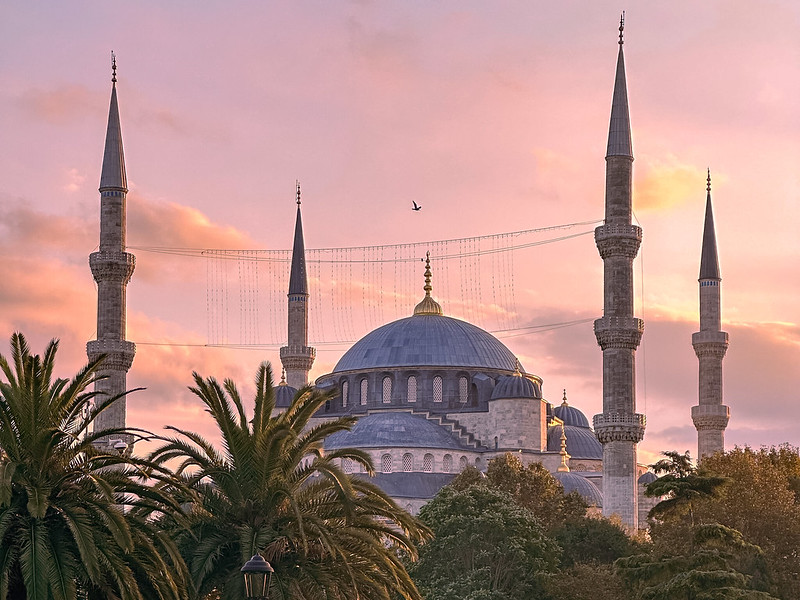
Basilica Cistern
To complete your tour of Istanbul’s historic squares, head underground to the mysterious Basilica Cistern, located just a few steps away from the Hagia Sophia.
This ancient subterranean water storage facility, built by the Romans in the 6th century, is supported by 336 marble columns that create an otherworldly atmosphere. It basically looks like this is where Daenerys would keep her dragons.
You can join this highly-rated tour (⭐ 4.5) where you’ll experience the Hagia Sophia, Blue Mosque, Topkapi Palace, and the Basilica Cistern with your guide. It’s a great way to discover the highlights of the popular Sultanahmet Square!

Hagia Sophia FAQ
What are the rules of Hagia Sophia?
There are a few restrictions and rules at Hagia Sophia that you should know:
– Remove shoes before stepping onto the mosque’s carpets
– Wear socks
– Women should wear a head covering. Headscarves are available at the entrance for free
– Men must wear pants, not shorts
– Photography is allowed, but be respectful and quiet
– Avoid disturbing, photographing, or standing in front of anyone praying
– No food allowed inside the Hagia Sophia since it’s a religious place
– Respect the mosque as a place of worship
Do you need to wear a scarf in Hagia Sophia?
Yes! But don’t worry if you don’t have one; you can borrow a headscarf for free at the mosque entrance.
Can I bring a backpack to Hagia Sophia?
Big luggage bags aren’t allowed inside the Hagia Sophia.
Unfortunately, there’s no cloakroom at the mosque where you can store it, so plan accordingly and pack light. You can bring a handbag.
How long does it take to visit the Hagia Sofia?
You can experience Hagia Sophia in about 30 to 45 minutes on your own. But if you book a guided tour, plan on spending about an hour there.
You can stay for as long as you like, both if you’re on a tour and on your own.
Can you take pictures inside the Hagia Sophia?
Absolutely! However, be respectful and avoid taking pictures of people who are praying.
Is the Hagia Sophia wheelchair accessible?
Yes, the ground floor is wheelchair-accessible. It’s no longer allowed to visit the upper floor (which is not wheelchair friendly due to all the steps and cobblestone pathways).
More posts about Istanbul you might like
- 20 best Turkish food: What to eat in Istanbul
- The ultimate Istanbul Cappadocia Pamukkale itinerary
- 12 most famous mosques in Istanbul you should visit now
- Perfect 1 day Istanbul itinerary: 12 best places to visit
- 10 reasons to visit Istanbul
- How to spend amazing 3 days in Istanbul
- The ultimate 7 day Turkey itinerary
Pin it!


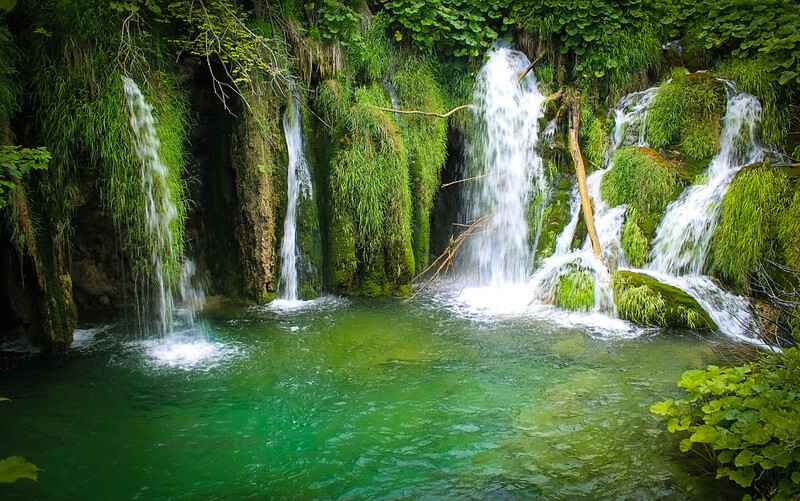
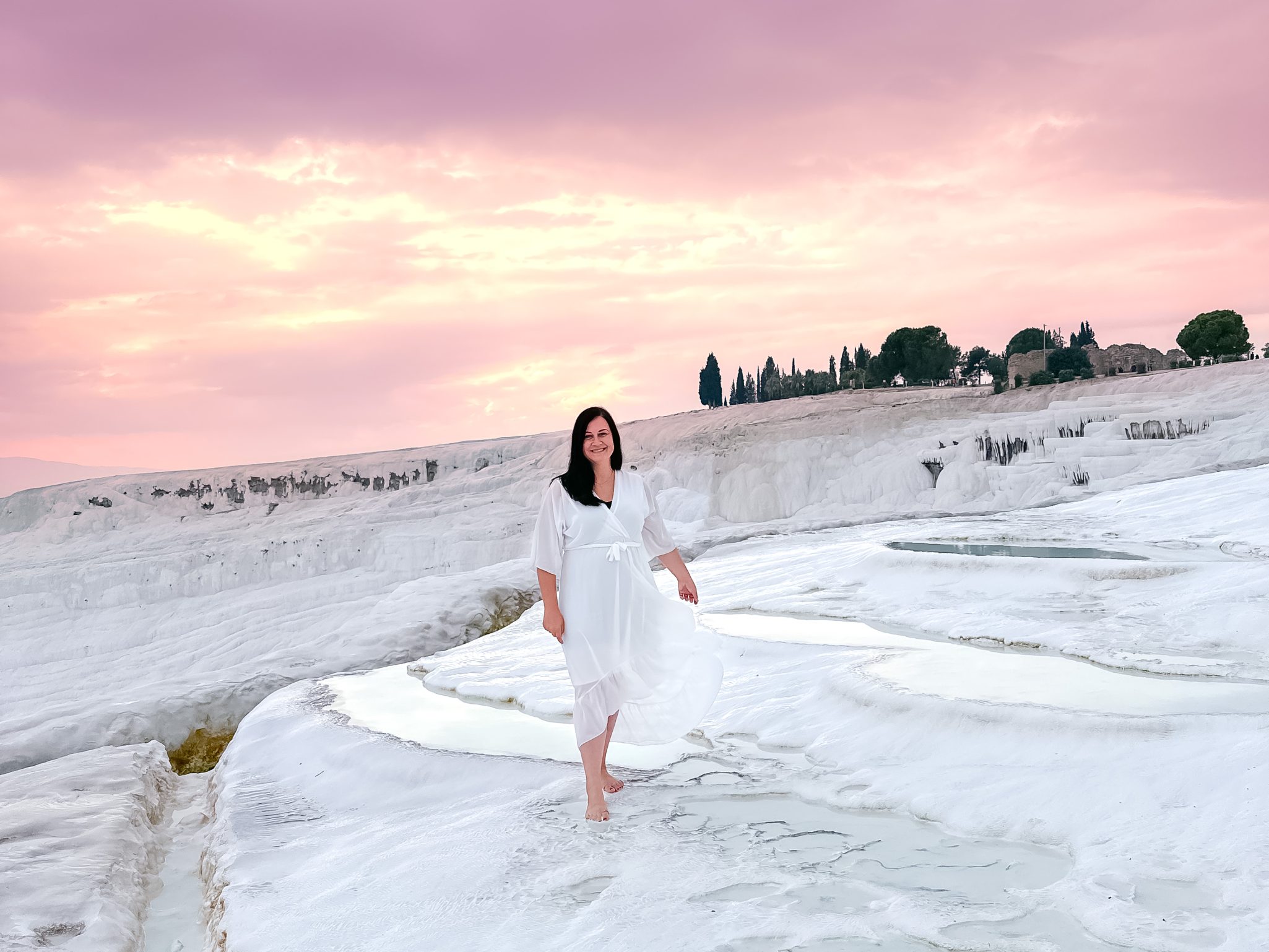

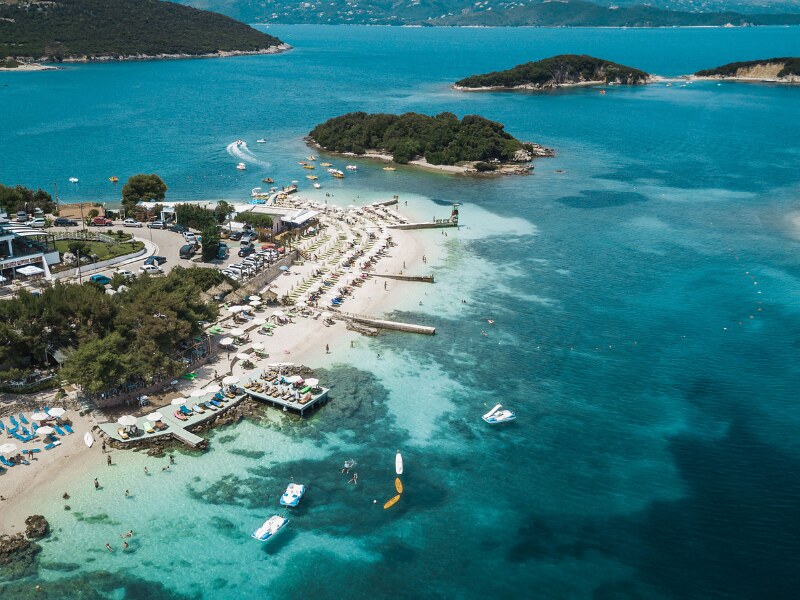


Thanks for this great article! I will be in Istanbul on July 19th, and I am not sure if women are allowed to wear t-shirts when visiting Hagia Sophia and mosques in general? Is it ok as long as the shoulders are covered?
Hi Camille,
Thanks for checking in! 🙂 Yes, you can wear a T-shirt in mosques and Hagia Sophia. You just need to cover your head, shoulders and legs.
It now costs €25 to get into Hagia Sophia and most of the ground floor is not accessible to tourists.
What a shame about the ground floor! Thank you for the input, though. I’ll make sure to update the info.